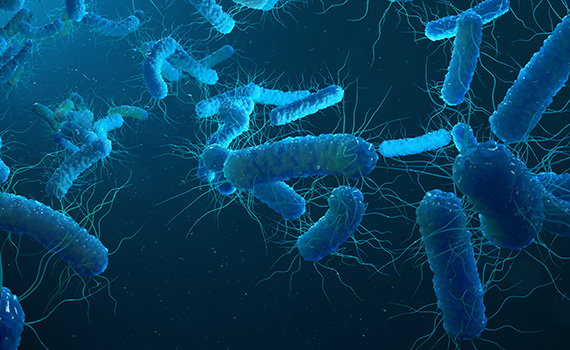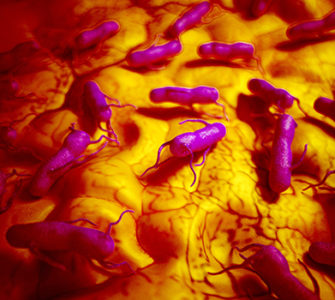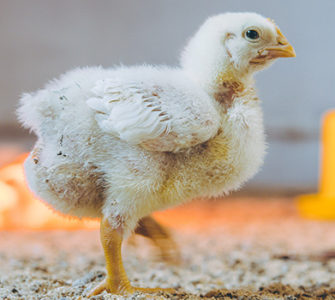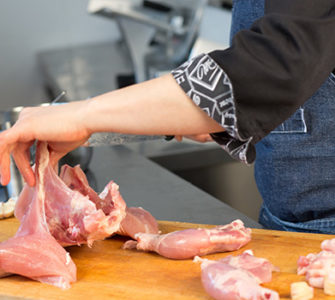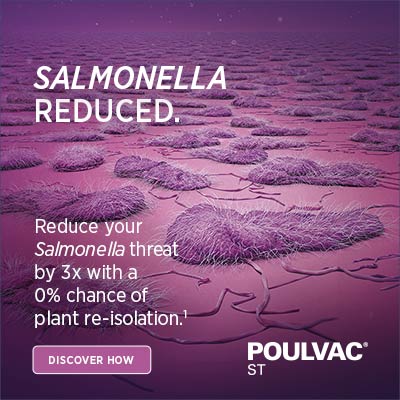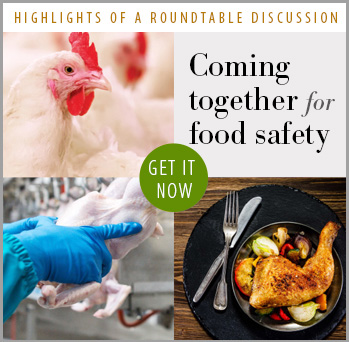Poulvac® ST cross-protects against different Salmonella serotypes
Salmonella vaccination is a vital part of an integrated approach to reducing the Salmonella load during the broiler life cycle, said Manuel Da Costa, DVM, PhD, associate director, Outcomes Research, Zoetis.
Salmonella control is an integrated system, where everything done in the production chain will impact other steps in the process. It starts at the parent stock level, goes through live production and ends at the processing plant. Vaccination plays a key role in this integrated control process, he said.
Shifting serotypes
A major challenge for the poultry industry is that the most prevalent Salmonella serotypes change over time. Making updates to vaccines to reflect the challenge strain is difficult; therefore, utilizing existing live vaccines that cross-protect against several Salmonella strains can be a better solution. That’s where Poulvac® ST vaccination fits in, Da Costa said.
Cross-protection is key
In studies, Poulvac ST was shown to cross-protect against Salmonella strains in serogroups B, C and D. Vaccines that cross-protect can benefit poultry complexes finding various strains in their processing plant, he said.
A series of 42-day challenges evaluated the percentage of ceca positive for Salmonella in vaccinated and unvaccinated birds. Vaccination with Poulvac ST protected broilers against Salmonella serogroups B, C and D, including S. Typhimurium, S. Heidelberg, S. Enteritidis, S. Kentucky and S. Hadar, Da Costa said.1
In comparison to the unvaccinated controls in these studies, Salmonella recovered in the ceca was reduced in birds vaccinated with Poulvac ST including: S. Typhimurium (Group B) 60% reduction; S. Heidelberg (Group B) 54% reduction; S. Enteritidis (Group D) 55% reduction; S. Kentucky (Group C) 34% reduction; and S. Hadar (Group C) 25% reduction.2
In two further studies, the effectiveness of Poulvac ST against S. Infantis in the ceca and liver/spleen was measured, Da Costa noted.
In the first study, birds were challenged with S. Infantis at 31 days of age and then evaluated at 41 days of age. Compared to the unvaccinated controls, birds vaccinated with Poulvac ST showed a 1.7-log reduction in the ceca, which translates to a lower Salmonella load going into the processing plant, Da Costa said.3
When evaluating Salmonella prevalence in the liver and spleen, vaccination with Poulvac ST resulted in a 9% reduction in S. Infantis, compared to controls, when broilers were directly challenged. There was also an 18% reduction in S. Infantis, compared to the controls, when broilers were horizontally exposed, he noted.4
Concurrently, the liver/spleen of vaccinated birds directly challenged had a 1.01-log reduction in S. Infantis versus the respective controls. The reduction was even greater when broilers were horizontally exposed, with the vaccinated birds having a 1.35-log reduction compared to the controls, he said.5
Early vaccination is a must
Poulvac ST, which is administered by spray at the hatchery and field boosted at 2 weeks, protects broilers throughout their life — from early challenges at the hatchery all the way to field challenges later in life, Da Costa said.
“It’s really important to apply the vaccine in the hatchery as the broilers are more susceptible to Salmonella early on,”6 he said.
The vaccine is ingested and colonizes the gut. This prevents wild-type Salmonella from infecting the bird via competitive exclusion.7 The vaccine also triggers the birds’ immune responses, which can protect them throughout growout, he explained.
“Our research results showed that the vaccine did not persist more than 3 weeks post vaccination. It should not be reisolated and recovered at the processing plant,” Da Costa said. This reduces the risk of cross-contamination at the processing plant and helps reduce false positives.
Live Salmonella vaccines control bacteria from the inside out and should be considered a key component of a producer’s Salmonella-control program, as vaccination lowers the Salmonella load going into the processing plant, he said.
Overall, Poulvac ST provides a balance between efficacy — increasing immunity and reducing Salmonella in the birds — and safety — lowering the risk of Salmonella positives at the plant — Da Costa said.
1 Data on file. Study Report Nos. B-393-98-A6.R; B-393-98-A8.R; B-393-99-A2.R; B-393-00-A1.R; B-393-01-A1.R. Zoetis, Inc.
2 Ibid.
3 Data on file. Study Report No. 032419-KL-70AQO-KC6023. Zoetis, Inc.
4 Data on file. Study Report No. 03-19-7 ADMJ. Zoetis, Inc.
5 Ibid.
7 Methner U, Berndt A, Steinback G. Combination of Competitive Exclusion and Immunization with an Attenuated Live Salmonella Vaccine Strain in Chickens. Avian Dis 2001;45-3: 631-638.
All trademarks are the property of Zoetis Services LLC or a related company or a licensor unless otherwise noted.
©2021 Zoetis Services LLC. All rights reserved. BIO-00312
Posted on October 7, 2021



